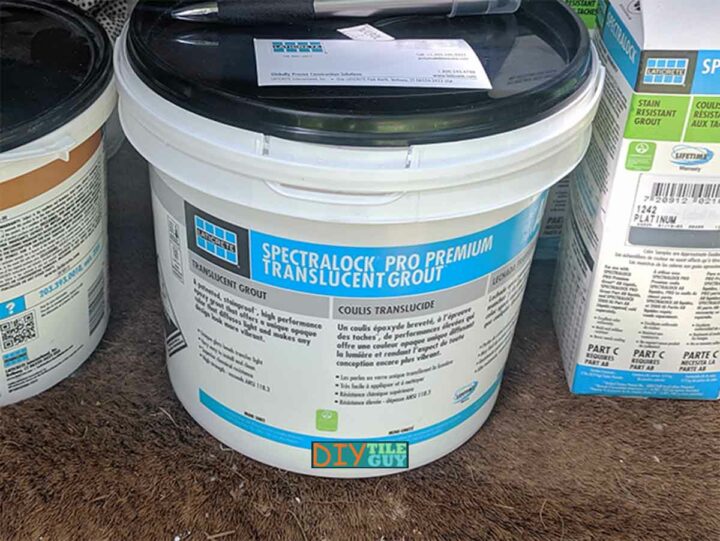“What’s so special about glass tile?” you may think to yourself. But there is a whole set of glass tile tools and techniques that are specific to itself.
So, what are these special techniques? And what tips and tricks for installing glass tile do you need to know to be successful?
This post covers seven different components of glass tile installation so that your project can be a smashing success!
Estimated reading time: 7 minutes

Pillar 1: Choose the right glass tiles
One of the first and best ways to set yourself up for success is to make good choices when buying your glass tiles.
Purchase glass tiles made from reputable manufacturers
Unfortunately, a lot of the glass tile that they sell at big box home improvement stores isn’t what you want to purchase.
Much of it comes from overseas, isn’t made to any standard, and has no one standing behind it when something goes wrong.
You’re much better off purchasing tiles from reputable manufacturers that supply detailed instructions, have a warranty department, and have warranty instructions in the package.
ANSI A132.7
This is the standard that applies to glass tiles and reputable manufacturers will meet these requirements. [1]
These standard sets guidelines for glass tile types, characteristics, and performance. It dictates such things as score & snap quality for consistent and predictable cutting of glass tiles.
Pillar 2: How to Cut Glass Tile
One big reason for carefully selecting glass tiles is when it comes to cutting them.
Well-made glass tiles cut cleanly on a consistent basis. Poorly made glass tiles cut inconsistently and are more prone to chipping.
Score and snap glass tile
As I mentioned in another post, scoring and snapping glass tiles produces a remarkably clean edge.
However, your success is determined by the cutter that you are using, the amount that you want to cut off, and the glass tile itself.
How to cut glass tile with a wet saw
A wet saw is practically a must when it comes to cutting glass tiles and you’ll want to invest in a glass tile blade.
The video below shows how I typically cut glass tiles with a wet saw and combines several of the techniques that I demonstrated in another post on how to cut glass tiles.
How to cut glass tile around outlets
If you’re installing glass tile on a kitchen backsplash then you are going to have to cut around some outlets.
A good tip is to round your inside corners rather than have sharp 90-degree angles. Glass is prone to cracking at those sharp corners and rounded corners reduce the possibility of problems down the road.
Pillar 3: Thinset for Glass Tile
Another way that glass tile differentiates itself from ceramic and porcelain tiles is that it’s really important to choose the right glass tile thinset for installing them.
Remember, above, where I said that reputable manufacturers will have good instructions for their glass tiles? Oftentimes, they will recommend specific products from a variety of thinset manufacturers for you to use.
Does thinset bond to glass?
If you want to bond to glass then you need to select the correct thinset. In general, you will want to use highly modified mortars meeting ANSI 118.4. Further, some thinsets are specifically made for glass, for example:
- Glass Tile Premium Thin-set Mortar by Custom Building Products
- Glass Tile Adhesive Lite from Laticrete
- Adesilex P10 Mosaic & Glass Tile by Mapei
Finally, you’ll want to be conscious of the color of the mortar underneath the glass tiles. The correct choice is nearly always to choose white mortar.
Mastic for glass tile
Don’t use any premixed mastic or thinset for glass tile. Some products say it’s OK but it’s a horrible idea, in my opinion.
Pillar 4: Troweling Techniques for Glass Tiles
Not only will you want to get the right mortar for installing glass tiles but glass has its own peculiar troweling techniques.
Since glass is translucent, and sometimes completely see-through), you want to make sure not to have any voids, bubbles, or pockets in the mortar underneath the tile.
The best way to accomplish this is to trowel your mortar with a notched trowel and then lightly smooth the notches over.
I demonstrate this technique at the 7:30-minute mark in the video below:
Also important is to back butter, or flat trowel, the back of the glass tile before you install it. Glass is see-through and this helps to prevent voids in the mortar which could be seen through the translucent glass.
Pillar 5: Allow for Movement
Installing movement joints is important in every tile installation but with glass, it’s especially important.
So, you’ll want to make sure to have a small space underneath the first row of tile and have a gap around all sides of the installation.
Remember, the gap doesn’t get filled with grout. It either remains open or gets filled with a flexible sealant that allows for movement.
Pillar 6: What kind of Grout do you use for Glass Tiles?
When it comes to grout, you want to make sure that it doesn’t scratch the glass tiles. Sometimes, the sand in some of the grouts can do this.
Personally, I’ve found it to be pretty rare that grout will scratch but you’ll want to test it first before going for it.
The best way is to set some extra tiles on a board and then grout them. Or start at someplace inconspicuous first before committing to the whole wall.
Grout made specifically for glass tiles
They do make some grouts specifically for glass tile installations. However, there is nothing in their performance that makes them a great match for glass.
Rather, it’s in their look. These grouts are semi-translucent and look great when installed with glass tiles. Examples of these types of grouts are:
- Fusion Pro Designer Series by Custom Building Products
- Flexcolor 3D by Mapei
- Spectralock Pro Premium Translucent Grout by Laticrete
You’ll want to be careful with the 3rd option that I’ve listed as it’s an epoxy grout and some manufacturers don’t recommend epoxy with their glass tiles.
This is another thing you’ll find in the instructions that reputable manufacturers provide.

Other grout options for glass tiles
If your grout lines are small enough (1/16th, or thinner) you can use non-sanded grout for these. Non-sanded grout (or unsanded) is a good option because it doesn’t have sand that can scratch.
If you need to fill larger grout joints then high-performance cement grouts are your best bet. They have a different kind of sand in them that won’t scratch as easily. Plus, they are just a better type of grout, in my opinion.
Pillar 7: Where to install- good applications (and bad)
Finally, the last item on the list is that you want to install your glass tiles where they can look great for decades.
I recommend that you refrain from installing them on shower floors or even floors, in general.
Glass can show moisture underneath and if moisture gets underneath your glass and stays there it can turn into mold. This mold will also be visible and frustrating because you can’t reach it to clean it out.
Further, floors are an impractical place to install glass as they will scratch and anything that you drop has the potential to send splinters of glass in any direction.
However, applications where glass tiles look great include backsplashes and other feature walls. Accenting shower walls is another place glass is frequently used.
A little thought and planning go a long way when it comes to installing glass tile. Where are you installing your glass tile? Did I miss anything in this post? Let me know in the comments.
FAQ for installing glass tiles
The correct color of thinset to use with glass tiles is almost always white.
Glass tile is definitely more difficult to install than porcelain or ceramic tile. It requires special tools and techniques to install the tiles successfully.
Glass tile is more labor intensive to install than porcelain or ceramic tile and therefore will cost more money to install.
Generally, you do not need to seal glass tile before grouting but you will want to always follow the manufacturer’s instructions for your own individual project.
It’s OK to install glass tile over drywall or painted drywall. However, if there are any spots where drywall compound is exposed then those areas will need to be painted with a primer prior to adhering glass tiles to them.
References:
- ANSI 137.2 webpage